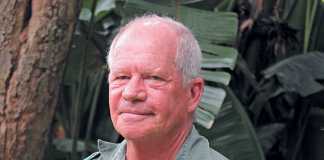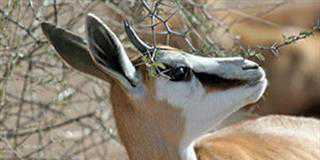
Photo: Heather Dugmore
Johannes van Rensburg, Afrikaner and Boran cattle farmer in the Eastern Cape, established the East Cape Midlands Boran Club (ECMBC) in 2011, due to the rising popularity of the breed in the province.
READ: The East African Borans – ‘the world’s hardiest breed’
On his 6 800ha farm, Rynheath, near Graaff-Reinet, he has a herd of 120 breeding cows, which includes 50 registered Afrikaners, in a stud his grandfather started 70 years ago. He currently breeds Afrikaners, and is building his herd of Afrikaner x Boran herd by putting registered Boran bulls onto SP Afrikaner cows and F1 Boran cows.
“I’m building up my herd to 200 breeding cows. I’ll retain 100 pure-bred Afrikaners and the balance will be Boran. Right now I have 40 Boran F1 cows of varying ages,” says Johannes.
Club members
Boran and Boran crosses have gained popularity in the Eastern Cape and the Karoo during the past few years, and Johannes recognised the need to form a Boran club.
“We had no sale yard for our cattle; the auctions were too far away,” he explains.
In October 2011 he brought together a group of the province’s Boran breeders and established the East Cape Midlands Boran Club (ECMBC). The club already has 33 members.

Johannes and Berna van Rensburg outside their 200-year-old farmhouse. They have been married for 33 years and have five children.
His first act as chairperson was to visit new and potential members to see their cattle and their farms. It shows his leadership and dedication, something he modestly denies.
“The credit for the ECMBC is not mine; it goes to our members, particularly to founding members such as Ed and Annette Kingwill who have put so much time and effort into making a success of our club, and to Ben Schoeman who brings 100 cattle to our sales,” says Johannes.
“This is why we are doing well; it’s all about the people. It’s about making the effort to welcome people to our annual sales, to talk about the breed with them, to answer their questions and to invite them to our farms so that they can get a feel for the cattle.”
A time to breed
Johannes’ three-month breeding season starts on 1 December with five self-bred registered Afrikaner bulls and five registered Boran bulls. One of these is Goldman (06 0073), son of the renowned Caesar (TLM 02-04) bred by Francois Smit of Fonteine Borans in North West.
“Goldman is balanced, with good width over the hindquarters and good body length,” comments Johannes, who uses the Falkirk Index for livestock measurement, assessment and bull selection.
He pays about R50 000 for his bulls, but says that good, registered Boran bulls are now available for R22 000 to R30 000.
“As the breed establishes itself and more animals come onto the market, bull prices are naturally coming down.”
When he first saw Borans in Zambia in 1983, they so impressed him that he wanted to import them immediately. Foot-and-mouth disease controls prevented import at that time. In 2007, he was able to buy Borans after seeing them in South Africa at Nampo.

“I like the Boran because it’s an African breed with a history dating back 1 300 years to Kenya, Ethiopia and Tanzania. Importantly, it is hardy, tick- and disease-resistant. Cows have plenty of milk and are excellent mothers and the small calves grow out well and wean at good weights.”
His cows weigh between 400kg and 450kg. “I run cows extensively in the Karoo and don’t want heavier animals,” he says.
Fertility and ethics in Boran breeding
Johannes weans at seven months by which stage his heifers weigh 185kg to 250kg and his bulls 215kg to 270kg. Boran F1 heifers are put to the bull at 14 months.
“The heifers calve easily and early as the Boran is very fertile. Rumours about Boran fertility issues are complete nonsense.”
He welcomes queries and invites people to view the cattle and records of any club members.
“Rumours like this start because some breeders treat their cows with hormones to super-ovulate them. This happens in all breeds. After these cows have had a couple of calves, the breeders sell them on as open cows, knowing they will have difficulty conceiving naturally. As a society we condemn this practice and we expect transparency from our members. This builds trust and confidence in a breed.”
READ: Owning the value chain – Cattle stud’s success with Borans
Johannes is against super-ovulation and explains that conception should be natural. “I believe in farming with nature.”
Food and water
Annual rainfall on Rynheath ranges from 250mm to more than 600mm, depending on local position. Johannes does not use supplements except in very dry conditions, when he supplies Voermol molasses meal, HPK12, phosphate and salt.
He does not put out salt blocks as the farm’s water is naturally brackish. With an average camp size of 300ha, he uses a four-camp rotation system, grazing each camp for three months and resting it for nine months. Cattle, sheep and goats are run in separate groups. His primary focus is on the health of his veld.

“Cattle impact revives the seed bank and has brought back many of the palatable grasses, which I want, and which is how the land originally looked,” he explains.
He has 15ha of agave (Agave americana), which he regards as a valuable drought reserve. During the 2008 to 2011 drought, he chopped up to 10t/day with an old forage harvester for animal feed. There are 10ha of lucerne and maize under cultivation used to finish cattle for auction or slaughter.
“Animals are sent to the abattoir in Graaff-Reinet from 18 months or from 200kg upwards.”
Johannes treats for ticks monthly between December and February. “Some members don’t spray at all because the Boran is naturally tick-resistant,” he says.
Value adding
Johannes feels that commercial cattlemen do themselves a disservice if they don’t have at least 25% Boran in their herds.
“The Eastern Cape has seen an increasing number of Nguni and Bonsmara cattlemen crossbreeding with Boran. Borans on European breeds also improve the base animal – they walk further and withstand the heat better.”
At a Boran information day held at Rynheath in July 2012, Johannes and other club members, including Wellwood Borans (Graaff-Reinet) and Three Rivers Boran (Adelaide), showed Boran stud cattle and Boran crossed with Black Angus, Afrikaner, Tuli and Galloway to demonstrate the benefit of the crosses.
The Boran Cattle Breeders’ Society has opened the breed and members can register F1, F2 and F3 animals up to SP. This generates interest and participation, and adds excitement to the auctions.
At the annual ECMBC sale in Cradock, all cows (registered and commercial) must be certified in-calf and/or have a calf at foot. At the 2012 sale, Johannes received an average price of
R8 500 for seven-month-old F1 Boran heifers, and R15 500 for certified in calf two-year-old F1 Boran heifers.
“I’ve been fortunate with my cattle; some other very good animals sold for less,” he says.
Sheep and goats
In addition to the cattle, Johannes runs 1 000 Merino ewes, 600 Red Russian ewes, 1 000 Angora kapaters, as well as 200 Boer goat ewes. “We diversify for a constant income from various sources,” he explains.
Originating from the Middle East where they are known as Awassi sheep, Red Russians are rare in South Africa. Johannes bought them from his father, who sourced them in Harrismith.
“They are hardy, fertile meat sheep and they’re fat-tailed with high quality tail fat for boerewors and droë wors. They also flock tightly which means they suffer fewer losses from predators,” says Johannes.

Johannes runs the Angora kapaters in a profit-sharing arrangement with a farmer from Golden Valley near Cookhouse. The two farmers split the profit from the fleece, and Johannes gets 10% of the meat value when they are slaughtered.
A cattleman from the age of 19, Johannes, now 54, has created a solid legacy empowering other breeders to build their herds. His parting advice to other cattle farmers, “The better you look after your stock the better they look after you.”
The East Cape Midlands Boran Club would like to remember one of its members, Owen Charles of the Charlton Boran Stud from Jansenville, who was murdered on his farm in 2012. The first Eastern Cape cattleman to farm with Boran, he was known as the Boran Whisperer because of his profound connection with these cattle.
Phone Johannes van Rensburg on 076 3747 225, or email him at [email protected].
This article was originally published in the 08 February 2013 issue of Farmers Weekly.













